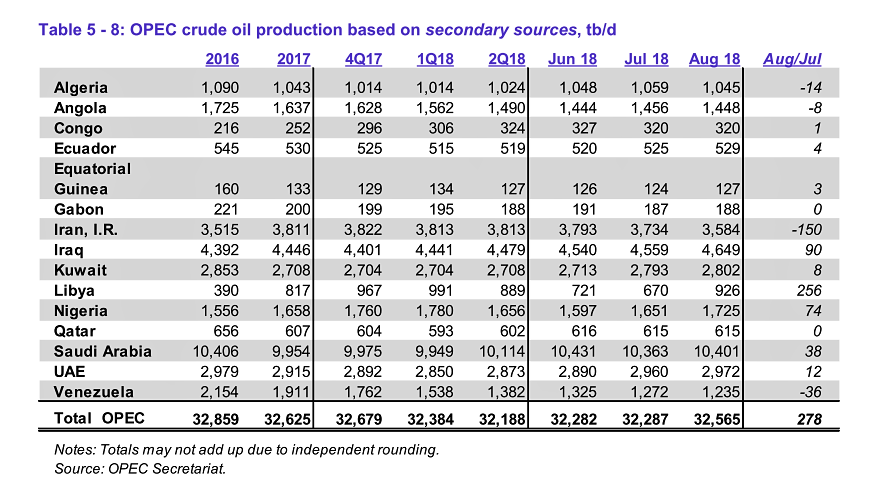OPEC Monthly Oil Market Report (MOMR) for this month was published last week on Wednesday, 12 September 2018. Looking at OPEC crude oil production data published in this month’s MOMR, here are the most important takeaways of the report that tell us a lot about OPEC crude oil production capacity going forward.

OPEC Crude Oil Production Data
MOMR Takeaways:
Total OPEC crude oil production capacity increased by 278,000 barrels per day in August 2018 compared with previous month.
The increase in OPEC crude oil production capacity was driven by output increase in Libya, Iraq, Nigeria, Saudi Arabia and UAE.
Most of the increase in OPEC crude oil production capacity came from Libya which pumped around 256,000 barrels per day more in August compared to 670,000 barrels per day in July 2018.
While the increase in Libya’s crude oil production is a good news to the cartel, the consistency of maintaining that level of production or even pumping more from Libya is under question due to the country’s unstable political situation. Therefore, it is difficult to take a decision based on Libya’s crude oil production potential due to its unpredicted fluctuations.
Iraq and Saudi Arabia came at the second and third levels in terms of production growth after Libya with 90,000 barrels per day and 74,000 barrels per day increase in crude oil production respectively.
While both countries seem to be able to pump more in the coming months, it is expected that the potential growth of crude oil production from both countries will be slow and limited. In the case of Saudi Arabia, it seems that the country is producing at full capacity and that is why there is currently more focus on further production enhancement from aging fields and the country is considering to restart crude oil production from the Neutral zone.
The total crude oil production increase from all 15 OPEC members during August 2018 was around 486,000 barrels per day. However, this oil production growth was offset by a total decline in OPEC crude oil production of around 208,000 barrels per day led by output decline from Iran, Venezuela, Algeria and Angola.
Iran’s crude oil production decline was the highest of all other members, and this is mainly due to the expected U.S. sanctions on Iran.
Iran crude oil production fell by 150,000 barrels per day in August 2018. This is the beginning of a trend that going forward would escalate due to U.S. sanctions that will be imposed on Iran in the coming months which could led to a total decline of 1.5 million barrels in Iran’s crude oil exports by year end.
OPEC crude oil production is expected to experience a decline in the coming months due to declines in Iran and Venezuela’s crude oil production which are expected to continue to fall going forward. It is also expected that crude oil production from Saudi Arabia, Iraq and other OPEC members will not be enough to offset declines in OPEC crude oil production from Iran and Venezuela. A tighter oil market would be translated into higher oil price that could drive Brent crude oil price slightly above $80 per barrel.

